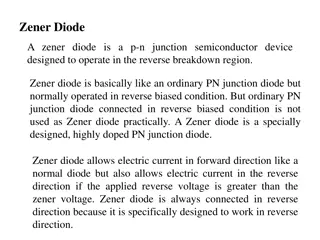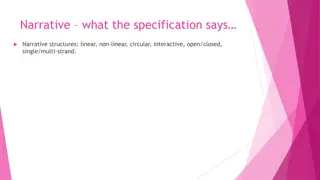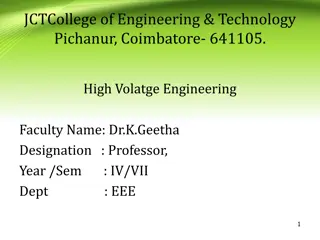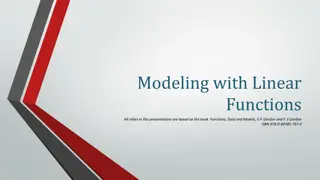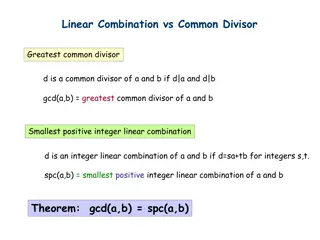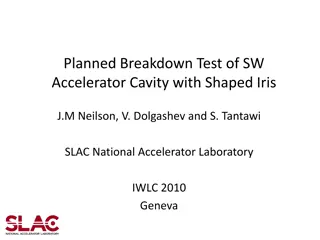Breakdown: Linear-time and Field-agnostic SNARKs for R1CS
Breakdown discusses linear-time and field-agnostic SNARKs for R1CS, focusing on achieving fast prover speeds and supporting circuits over arbitrary finite fields. SNARKs offer efficient proof systems with sub-linear proof sizes and verification costs. The work aims to eliminate the need for FFT-friendly fields and enable proof generation in linear time without relying on trusted setups. Various applications and efficiency improvements in SNARK technology are highlighted.
Download Presentation

Please find below an Image/Link to download the presentation.
The content on the website is provided AS IS for your information and personal use only. It may not be sold, licensed, or shared on other websites without obtaining consent from the author. Download presentation by click this link. If you encounter any issues during the download, it is possible that the publisher has removed the file from their server.
E N D
Presentation Transcript
Brakedown: Linear-time and field-agnostic SNARKs for R1CS Alexander Golovnev, Jonathan Lee, Srinath Setty, Justin Thaler, and Riad S. Wahby Microsoft Research Georgetown Nanotronics A16Z CMU
What is a SNARK? Prover (?) Verifier (?) A proof establishing the knowledge of a witness to a statement ? knows a witness ? such that SHA256 ? = ?, for a public value ? General: ? knows ? such that ? ?,? = 1, for a public circuit ? and input ? A trivial proof system:? sends its ?, and ? checks if ? ?,? = 1 A SNARK achieves better properties: The size of the proof is sub-linear in the size of the statement proven The cost to verify is sub-linear in the cost to check the witness 2
SNARKs have many applications Rollups/zkVMs zkBridge VDFs zkML PhotoProof Public key transparency The prover time is a key bottleneck in SNARKs Expensive to apply SNARKs to large circuits (e.g., 230 gates) 3
Our focus in this work (1) SNARKs with the fastest possible prover Current SNARKs require ? to be: FFT-friendly, or the scalar field of a fast (pairing-friendly) elliptic curve Many statements (e.g., ECDSA over P-256) require field emulation Makes proving expensive (2) SNARKs that can prove a circuit ? defined over an arbitrary finite field ? 4
How fast can we hope the SNARK prover to be? Recall: ? proves the knowledge of ? ? ?,? = 1 A lower bound on ? time is the runtime of direct witness-checking (?): Given ? and ?, check if ? ?,? = 1 Letting ? denote the time taken by ?, then the fastest prover time is: ? ? for some constant ? SNARKs with the prover time of ? ? are called linear-time SNARKs No FFTs or MSMs of size O(T)! Merkle-hashing an O(T)-sized vector is OK [AHIV17, BCGGHJ17] (with some novel hash functions, it can be implemented in linear time) 5
Brakedown in a nutshell Plausibly post- quantum secure Linear-time SNARK No trusted setup The first implemented SNARK with either property Supports any large (e.g., 128-bit) field Supports R1CS, extends to CCS [STW23] Efficiency (? is size of R1CS instance and ? is security parameter): ? time: ?(?) field operations Proof sizes: ?( ??), and ? time: O(|x| + ??) field operations Follow-up works provide efficiency improvements: [DP23] provides ~2 improvement in prover time and proof sizes [Hab23] provides ~25% reduction in commitment costs Orion, Orion+, and Vortex provide asymptotic improvements to proof sizes and verifier times (at the loss of some other properties) 6
Rest of this talk Background on the modern SNARK design Design of Brakedown Experimental results 7
Recipe in modern SNARK constructions (1) Construct a succinct interactive argument of knowledge: Polynomial commitment scheme Polynomial IOP (2) Render it non-interactive using the Fiat-Shamir transformation Exceptions: Linear-PCP-based SNARKs (e.g., Groth16) Folding-scheme-based SNARKs (e.g., Nova) 8
What is a polynomial IOP for CSAT? Interactive protocol for ? to convince ? that it knows a ? ? ?,? = 1 Notions of completeness, KS, etc. (like in SNARKs) Use preprocessing of ? to avoid the verifier having to read it in the online phase ? s message in each round is a polynomial ? can only evaluate the polynomial at a point ?1 ?1?1 ? ? ? ? ? ? outputs a bit based on challenges and values computed ? ?,?,?1, ,? ,?1, ,? {0,1} 9
Polynomial commitment scheme (PCS) Suppose ? has a polynomial ? ? binds itself to ? by sending a commitment ? can ask for an evaluation of the committed polynomial Commitments are short and proofs are quick to verify Notions of completeness, binding, extractability, etc. ? ? ? outputs a bit ? ?,?,?,? {0,1} 10
Polynomial IOP + PCS for CSAT Interactive argument for ? to convince ? that it knows a ? ? ?,? = 1 ? s message in each round is a commitment ? provides an evaluation along with a proof Make it non-interactive with Fiat-Shamir transformation, obtaining a SNARK ? ? ? outputs a bit ? ?,?,?1, ,? ,?1, ,? ,?1, ,? {0,1} 11
Recipe in modern SNARK constructions Polynomial IOP PCS KZG [KZG10], [PST13] IPA [BCCGP16] Hyrax [WTs+18] Dory [Lee21] Spartan [S19] Plonk [GWC19] Marlin [CHM+19] MSMs Ligero-PC [AHIV17] FRI-based [BBHR18] Virgo-PC [ZXZS20] FFTs Require FFTs of size proportional to the circuit size 12
Rest of this talk Background on the modern SNARK design Design of Brakedown Experimental results 13
Brakedown: A linear-time SNARK based on a new PCS Spartan s Brakedown PCS Polynomial IOP [S19] ? time: ?(?)?-ops ? time: ?(log ?)?-ops Communication: ?(log ?)? elements Commit time: ?(?)?-ops ? time: ?(?)?-ops ? time: ? ???-ops Communication: ? ?? elements of ? 14
Brakedown PCS Builds on prior theoretical work [AHIV17, BCGGHJ17, BCG20] An implicit result in these works: A PCS with a linear-time committer and prover, given an error correcting code with a linear-time encoder Unfortunately: prior linear-time encodable codes [Spi96, DI14] are impractical Brakedown s key contributions: Distill a linear-time polynomial commitment scheme from prior works Provide a suitable error-correcting code that is practical 15
An overview of the PCS: Commitment Consider: Univariate polynomials in the monomial basis Brakedown uses the PCS for multilinear polynomials in the evaluation basis Let ? ?? be the coefficient vector of the polynomial ? to be committed. Let ? = ?2, and view ? as an ? [?] matrix ? = (?1, ,??). ?1 ?(?1) Merkle hash columns Encode each row ?2 ?(?2) ? rows ?? ?(??) ? is the encode method of a linear ECC # columns = ? ? 1 Columns of the encoded matrix ?columns 16
Testing if the commitment is valid The Merkle hash binds ? to some matrix ? = ?1,?2, ,?? A malicious prover may commit to a matrix that is not well-formed Well-formed = Each row ?? of ? is a codeword ? ?? for some ?? Testing procedure: ? sends (?1, ,??) ? sends a vector ? = ??? ?? ? runs ? ?(?) ? picks ?/? column indices and checks if ??= ??? ( ??,? are read from the Merkle tree) ?1 ?2 . . . . . . . . . . ?? . . . . . ??,? . . . . . ? 17
Proving the evaluation of a committed polynomial Example ? ? = ? + 2 ?2+ 3 ?3 0 2 ? = 1 3 ? can be evaluated at a point ? ? by exploiting the following identity. 0 2 1 ? ? = ? 1 ?2 1 3 ? ? ? Evaluation procedure: ? and ? repeat the testing except weights are replaced by L = 1,? As in testing, ? checks the consistency with random column openings Then, the verifier computes ? ? = ??? ?? 18
Completeness of the PCS ?1 ?(?1) Encode each row ?2 ?(?2) ? rows ?? ?(??) ? is the encode method of a linear ECC ?columns If every row of the committed matrix is a valid codeword, then by the linearity of the code, so is any linear combination of rows An honest ? will pass ? s checks 19
Binding property of the PCS Lemma (informal): If ? s checks pass with probability 2 ?, then ? is bound to some polynomial of the appropriate degree ? must answer any evaluation query ? with ?(?) Proof sketch (key lemma due to [RVW14, AHIV17]): If any row of the committed matrix is far from all codewords, then w.h.p RLC of the rows will be just as far from all codewords ? will fail the testing procedure w.h.p So, if ? passes tests, then ? knows that every row of ? is close to a codeword This property turns out to be sufficient to establish binding 20
PCS costs for a polynomial with for ? coefficients Commitment size: a single Merkle root (e.g., 32 bytes) Proof size and ? time O (?/?) ? ? time dominated by: Building Merkle-tree over ? ? field elements, and Encoding ? vectors of size ? (a key bottleneck) 21
Brakedown provides a practical code For ? ?? encoding time is 17 ? operations Exploits specific characteristics in our setting (details in the paper) No need for efficient decoding Work over large (e.g., 128-bit) fields Randomized codes are acceptable Both ? and ? only do encoding Decoding is not even needed for KS! Large fields are required for the IOP s soundness w.h.p a random code satisfies a distance bound 22
A high-level overview of the code construction For a message ? ??, the codeword has 3 parts: E ? = ?,?,? The first part is the systematic part , so just copy the message ? ?,? is computed in three steps 1. Multiply ? by a random sparse ? ? 2. Obtain ? = E(?) of length ? 3by recursively encoding ? 3. Obtain ? of length ? 5matrix to to get a vector of length ? 5 3by multiplying ? by a random sparse ? 3 ? 3 matrix 1 20 and rate 3 (for relative distance ? 5) 23
Systematic part Recursively encode a compressed version of the message Multiply the second component with a random sparse matrix Distance analysis of the code construction (please see the paper) 24
Rest of this talk Background on the modern SNARK design Design of Brakedown Experimental results 25
Implementation Implemented in Rust, with many optimizations (details in the paper) We also implement a variant of Brakedown that uses Reed-Solomon codes Gives up linear-time prover, but provides smaller proofs than Brakedown Both schemes are available from fork of Spartan (https://github.com/conroi/Spartan) 26
Performance for R1CS statements with 220 constraints Prover time (s) Proof size (KB) Verifier time (ms) Ligero [CCS17] 69 20,000.0 31,000 Hyrax [S&P18] 486 58.0 7,700 SNARKs for uniform circuits Aurora [EUROCRYPT19] 485 1,600.0 108,000 Spartan w/ Hyrax-PC [CRYPTO20] 6 48.0 366 Brakedown 3 10,230 660 Groth16 [EUROCRYPT16] 76 0.2 3 Fractal [EUROCRYPT20] 880 2,500.0 220 SNARKs for non- uniform circuits Spartan w/ Hyrax-PC [CRYPTO20] 45 142.0 100 Brakedown 33 53,846 2,219 Brakedown offers the fastest prover Proof sizes are large, but they can be reduced (e.g., see Orion and Orion+)
Summary Brakedown is a linear-time and field-agnostic SNARK Key contributions: A linear-time polynomial commitment scheme (distilled from prior work) A practical linear-time encodable code to instantiate the PCS Combine the new PCS with Spartan s polynomial IOP to get a linear-time SNARK 28



